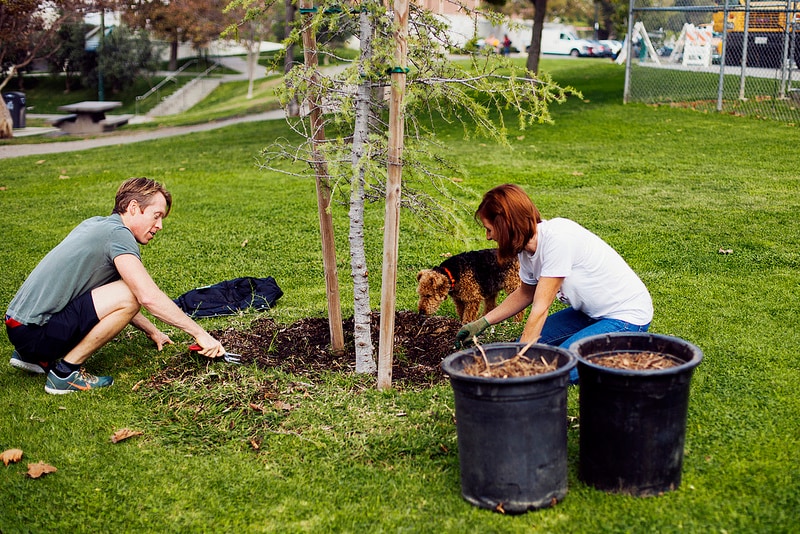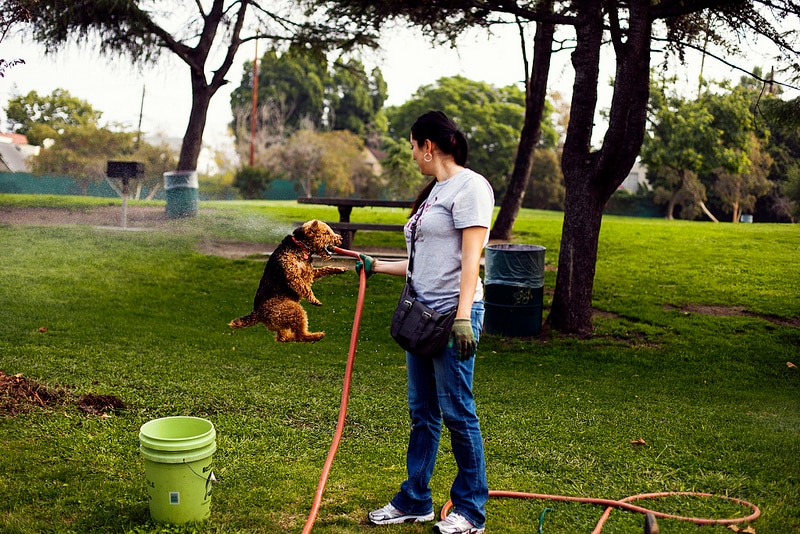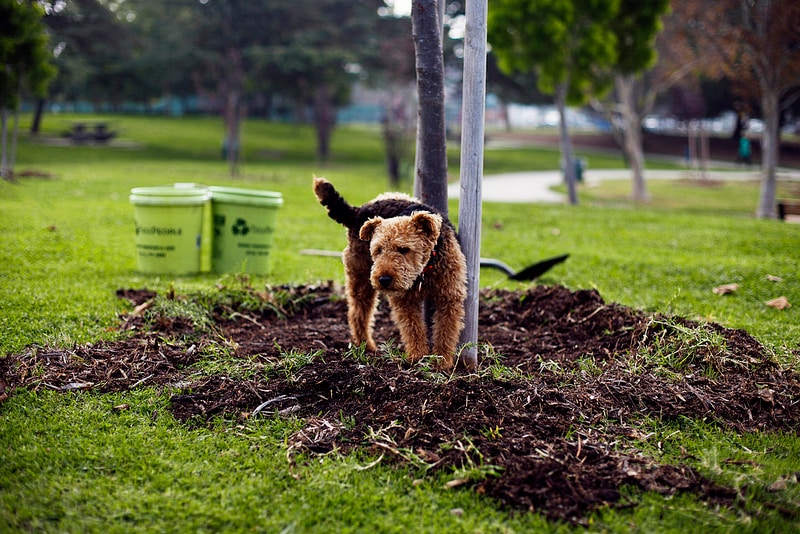This article originally appeared on Dr. Mahaney’s The Daily Vet column on PetMD as Why Every City Needs a Dog Park.
 Having lived in urban areas (Philadelphia, Washington, D.C., Seattle, and now Los Angeles) throughout my adult life, I’ve always relished having accessibility to green spaces that provide an oasis from the sprawl of city sidewalks and blacktop.
As I also have kept dogs during my stays in these cities, I know of the important role green spaces play in providing a variety of resources for my fellow canine owners and the dogs for which they care-take (and those of you who also get out and about with a feline friend). Therefore, promoting the general betterment of parks, forests, and hiking trails is a priority for me as a citizen.
Recently, I helped out at an event representing the partnership between businesses that also strive to improve the environment and quality of life of pets. (Pictures at the bottom of the post.) The PR Web report, Healthy Spot® and The Honest Kitchen® Partner with TreePeople to Help Green Los Angeles’ Urban Environment, details the collaboration.
Healthy Spot, a pioneering independent pet supplies and services boutique, and The Honest Kitchen, a producer of healthy all natural pet food products, today announced a one year partnership with Los Angeles non-profit organizationTreePeople, to help plant trees and conduct other important environmental initiatives in Los Angeles’s urban areas.
Beginning November 1st, 2013, every purchase of a 10 lb. box of The Honest Kitchen’s dog food at Healthy Spot locations in the greater Los Angeles area will directly support TreePeople’s work in greening the city.
“We are excited to partner with the Honest Kitchen and our customers to support the TreePeople’s sustainability and greening initiative in our local communities. We are eager to see what we can do together in this new program,” stated Andrew Kim, one of Healthy Spot’s co-founders.
TreePeople has a long-range vision to make Los Angeles greener, healthier, and more sustainable. TreePeople involves citizen volunteers and local businesses engaging with each other to grow L.A.’s tree canopy and create a secure and clean water local supply, for example by:
Having lived in urban areas (Philadelphia, Washington, D.C., Seattle, and now Los Angeles) throughout my adult life, I’ve always relished having accessibility to green spaces that provide an oasis from the sprawl of city sidewalks and blacktop.
As I also have kept dogs during my stays in these cities, I know of the important role green spaces play in providing a variety of resources for my fellow canine owners and the dogs for which they care-take (and those of you who also get out and about with a feline friend). Therefore, promoting the general betterment of parks, forests, and hiking trails is a priority for me as a citizen.
Recently, I helped out at an event representing the partnership between businesses that also strive to improve the environment and quality of life of pets. (Pictures at the bottom of the post.) The PR Web report, Healthy Spot® and The Honest Kitchen® Partner with TreePeople to Help Green Los Angeles’ Urban Environment, details the collaboration.
Healthy Spot, a pioneering independent pet supplies and services boutique, and The Honest Kitchen, a producer of healthy all natural pet food products, today announced a one year partnership with Los Angeles non-profit organizationTreePeople, to help plant trees and conduct other important environmental initiatives in Los Angeles’s urban areas.
Beginning November 1st, 2013, every purchase of a 10 lb. box of The Honest Kitchen’s dog food at Healthy Spot locations in the greater Los Angeles area will directly support TreePeople’s work in greening the city.
“We are excited to partner with the Honest Kitchen and our customers to support the TreePeople’s sustainability and greening initiative in our local communities. We are eager to see what we can do together in this new program,” stated Andrew Kim, one of Healthy Spot’s co-founders.
TreePeople has a long-range vision to make Los Angeles greener, healthier, and more sustainable. TreePeople involves citizen volunteers and local businesses engaging with each other to grow L.A.’s tree canopy and create a secure and clean water local supply, for example by:
 Dr. Patrick Mahaney
Images by Maria McGinley via Flickr
Dr. Patrick Mahaney
Images by Maria McGinley via Flickr
 Patrick Mahaney and Lucy Postins work under Cardiff’s observation
Patrick Mahaney and Lucy Postins work under Cardiff’s observation
 Cardiff jumps for joy when the hose turns on
Cardiff jumps for joy when the hose turns on
 Cardiff christens a tree in Pan Pacific Park
Cardiff christens a tree in Pan Pacific Park
 Main Image: Cardiff having a happy day at the park
Thank you for reading this article. Your questions and comments are completely welcome (I’ll respond).
Please feel free to communicate with me through Twitter (@PatrickMahaney) and follow my adventures in veterinary medicine by liking Patrick Mahaney: Veterinarian Acupuncture Pain Management for Your Pets on Facebook.
Copyright of this article (2013) is owned by Dr Patrick Mahaney, Veterinarian and Certified Veterinary Acupuncturist. Republishing any portion of this article must first be authorized by Dr Patrick Mahaney. Requests for republishing must be approved by Dr Patrick Mahaney and received in written format.
Main Image: Cardiff having a happy day at the park
Thank you for reading this article. Your questions and comments are completely welcome (I’ll respond).
Please feel free to communicate with me through Twitter (@PatrickMahaney) and follow my adventures in veterinary medicine by liking Patrick Mahaney: Veterinarian Acupuncture Pain Management for Your Pets on Facebook.
Copyright of this article (2013) is owned by Dr Patrick Mahaney, Veterinarian and Certified Veterinary Acupuncturist. Republishing any portion of this article must first be authorized by Dr Patrick Mahaney. Requests for republishing must be approved by Dr Patrick Mahaney and received in written format.
 Having lived in urban areas (Philadelphia, Washington, D.C., Seattle, and now Los Angeles) throughout my adult life, I’ve always relished having accessibility to green spaces that provide an oasis from the sprawl of city sidewalks and blacktop.
As I also have kept dogs during my stays in these cities, I know of the important role green spaces play in providing a variety of resources for my fellow canine owners and the dogs for which they care-take (and those of you who also get out and about with a feline friend). Therefore, promoting the general betterment of parks, forests, and hiking trails is a priority for me as a citizen.
Recently, I helped out at an event representing the partnership between businesses that also strive to improve the environment and quality of life of pets. (Pictures at the bottom of the post.) The PR Web report, Healthy Spot® and The Honest Kitchen® Partner with TreePeople to Help Green Los Angeles’ Urban Environment, details the collaboration.
Healthy Spot, a pioneering independent pet supplies and services boutique, and The Honest Kitchen, a producer of healthy all natural pet food products, today announced a one year partnership with Los Angeles non-profit organizationTreePeople, to help plant trees and conduct other important environmental initiatives in Los Angeles’s urban areas.
Beginning November 1st, 2013, every purchase of a 10 lb. box of The Honest Kitchen’s dog food at Healthy Spot locations in the greater Los Angeles area will directly support TreePeople’s work in greening the city.
“We are excited to partner with the Honest Kitchen and our customers to support the TreePeople’s sustainability and greening initiative in our local communities. We are eager to see what we can do together in this new program,” stated Andrew Kim, one of Healthy Spot’s co-founders.
TreePeople has a long-range vision to make Los Angeles greener, healthier, and more sustainable. TreePeople involves citizen volunteers and local businesses engaging with each other to grow L.A.’s tree canopy and create a secure and clean water local supply, for example by:
Having lived in urban areas (Philadelphia, Washington, D.C., Seattle, and now Los Angeles) throughout my adult life, I’ve always relished having accessibility to green spaces that provide an oasis from the sprawl of city sidewalks and blacktop.
As I also have kept dogs during my stays in these cities, I know of the important role green spaces play in providing a variety of resources for my fellow canine owners and the dogs for which they care-take (and those of you who also get out and about with a feline friend). Therefore, promoting the general betterment of parks, forests, and hiking trails is a priority for me as a citizen.
Recently, I helped out at an event representing the partnership between businesses that also strive to improve the environment and quality of life of pets. (Pictures at the bottom of the post.) The PR Web report, Healthy Spot® and The Honest Kitchen® Partner with TreePeople to Help Green Los Angeles’ Urban Environment, details the collaboration.
Healthy Spot, a pioneering independent pet supplies and services boutique, and The Honest Kitchen, a producer of healthy all natural pet food products, today announced a one year partnership with Los Angeles non-profit organizationTreePeople, to help plant trees and conduct other important environmental initiatives in Los Angeles’s urban areas.
Beginning November 1st, 2013, every purchase of a 10 lb. box of The Honest Kitchen’s dog food at Healthy Spot locations in the greater Los Angeles area will directly support TreePeople’s work in greening the city.
“We are excited to partner with the Honest Kitchen and our customers to support the TreePeople’s sustainability and greening initiative in our local communities. We are eager to see what we can do together in this new program,” stated Andrew Kim, one of Healthy Spot’s co-founders.
TreePeople has a long-range vision to make Los Angeles greener, healthier, and more sustainable. TreePeople involves citizen volunteers and local businesses engaging with each other to grow L.A.’s tree canopy and create a secure and clean water local supply, for example by:
- mobilizing neighborhood volunteers to plant and care for trees
- caring for trees to shade walkways, streets, buildings and recreation areas to reduce energy and water use
- unpaving hard asphalt surfaces and restoring healthy soil that enables rainwater to soak into the ground
- ensuring downspouts direct rainwater into the ground instead of running off onto pavement and into storm drains
- establishing native and drought-tolerant plants and grasses to reduce the need for irrigation
Spots for Pets to Socialize
Green spaces provide dogs a place for interaction with others of their species. In general, a well-socialized dog that interacts with other dogs will be less dependent on their human caretakers to satisfy their socialization needs. Dogs’ owners also benefit, as getting out and about at the park or hiking trail may permit them to meet new friends or even love interests. Locations for Pets to Urinate and Defecate Some dogs are forced to urinate and defecate on less-than-desirable substrates, such as cement sidewalks or greenery-blighted areas. Having trees and grass on which they can comfortably void is more ideal to teach a puppy the appropriate place to poop or pee. Additionally, geriatric and mobility-compromised pets benefit from the traction and temperature regulation provided by a grassy surface instead of squatting or stretching in a potentially uncomfortable position on a solid surface that can exude extreme heat or cold. Of course, all pet waste should be immediately picked up by the overseeing person to ensure that fecal bacteria, viruses, or parasites don’t foul our common ecosystem or create any degree of general unsightliness. Areas for Pets to ExerciseAreas for Pets to Exercise
Especially for apartment-dwelling dogs lacking their own yard, green spaces are vitally important for ensuring that physical activity can be offered daily or even multiple times per day. Partaking in regular exercise is especially crucial considering the obesity epidemic faced by many U.S. pets. In 2012, the Association for Pet Obesity Prevention (APOP) conducted the sixth annual National Pet Obesity Awareness Day Survey and determined that 52.5 percent of dogs and 58.3 percent of cats are overweight or obese, according to their veterinarians’ diagnosis. That’s a staggering 80 million dogs and cats suffering from or likely developing a variety of potentially irreversible health problems, including arthritis, traumatic ligament injury, high blood pressure, pancreatitis, cancer, and more. Although walking or jogging on-leash with their owners on city sidewalks or streets is beneficial for many canines, having a vast space for off-leash activities like ball chasing or playing with other dogs can provide an enhanced level of exertion. Additionally, the softer surface provided by grass, mulch, soil, or other substrates is kinder to dogs’ joints. Upon cleaning myself up after planting, I witnessed my own pooch, Cardiff, enjoying his role at the event by hamming it up for the camera, doing his own version of tree watering, and jumping enthusiastically at a hose’s water spray. Aaah, dogs will be dogs! Dr. Patrick Mahaney
Images by Maria McGinley via Flickr
Dr. Patrick Mahaney
Images by Maria McGinley via Flickr
 Patrick Mahaney and Lucy Postins work under Cardiff’s observation
Patrick Mahaney and Lucy Postins work under Cardiff’s observation
 Cardiff jumps for joy when the hose turns on
Cardiff jumps for joy when the hose turns on
 Cardiff christens a tree in Pan Pacific Park
Cardiff christens a tree in Pan Pacific Park
 Main Image: Cardiff having a happy day at the park
Thank you for reading this article. Your questions and comments are completely welcome (I’ll respond).
Please feel free to communicate with me through Twitter (@PatrickMahaney) and follow my adventures in veterinary medicine by liking Patrick Mahaney: Veterinarian Acupuncture Pain Management for Your Pets on Facebook.
Copyright of this article (2013) is owned by Dr Patrick Mahaney, Veterinarian and Certified Veterinary Acupuncturist. Republishing any portion of this article must first be authorized by Dr Patrick Mahaney. Requests for republishing must be approved by Dr Patrick Mahaney and received in written format.
Main Image: Cardiff having a happy day at the park
Thank you for reading this article. Your questions and comments are completely welcome (I’ll respond).
Please feel free to communicate with me through Twitter (@PatrickMahaney) and follow my adventures in veterinary medicine by liking Patrick Mahaney: Veterinarian Acupuncture Pain Management for Your Pets on Facebook.
Copyright of this article (2013) is owned by Dr Patrick Mahaney, Veterinarian and Certified Veterinary Acupuncturist. Republishing any portion of this article must first be authorized by Dr Patrick Mahaney. Requests for republishing must be approved by Dr Patrick Mahaney and received in written format.
